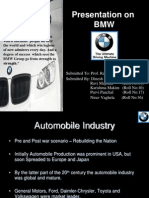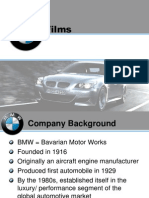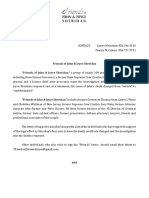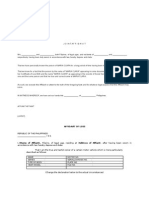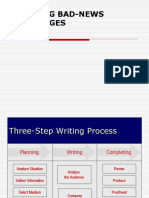Professional Documents
Culture Documents
Strategic Management: Macmillan and Tampoe OUP
Strategic Management: Macmillan and Tampoe OUP
Uploaded by
Muktesh MukulOriginal Description:
Original Title
Copyright
Available Formats
Share this document
Did you find this document useful?
Is this content inappropriate?
Report this DocumentCopyright:
Available Formats
Strategic Management: Macmillan and Tampoe OUP
Strategic Management: Macmillan and Tampoe OUP
Uploaded by
Muktesh MukulCopyright:
Available Formats
Strategic Management
Macmillan and Tampoe
OUP
1 (c) Macmillan & Tampoe 2001
Case Examples
BMW in 1999
2 (c) Macmillan & Tampoe 2001
The reasons for choosing BMW
The company is well known to most students in the UK
The industry structure and challenges quite well understood
It’s a sizable company but a minnow (table C3.1) in terms of
global car production and sales.
Strong European and US brand image and customer base but
faces tough decisions on how to move forward
Faced with many options – merge, get taken over, buy to
grow, move into new segment, become specialist supplier,
stay as now.
Interesting ownership structure.
Provides comparison with Japanese companies who have
moved into the UK to spread their wings in Europe
3 (c) Macmillan & Tampoe 2001
Critical Strategic Issues
Car industry converging into mega-corporations where
size seems to be the determining factor
BMW very small in comparison to top five (see table
C3.1)
Can it survive by staying roughly the same size, selling
their extremely successful and sought after high margin
cars to discerning customers?
If not, how can it grow?
How can it retain current ownership structure so that
major shareholders do not see their ownership diluted or
lose control of the company?
4 (c) Macmillan & Tampoe 2001
Consequences of a growth strategy
Can it exploit its core competence in new markets?
Can it modify its ethos to match new markets?
Should it abandon its proven competence and approach
to business?
How does it choose a new approach?
Should it seek to develop a new customer base with
wider potential sales?
Should it spread its brand over wider range of products?
How will it counter threats to its new approach?
How will it position itself vis-a-vis it chosen competition?
5 (c) Macmillan & Tampoe 2001
Strengths pre-Rover acquisition
Company ranked among the more admired companies
in the auto industry
Its chief executive a respected industry and national
figure with the industry in his blood
Customers are loyal to the brand
5 series is considered the benchmark for the executive
car market
Profitable
Perceived to be invincible
Company announces expansion plans by buying Rover
from BAe in the UK
6 (c) Macmillan & Tampoe 2001
Possible causes of BMW success
Its aircraft and motorcycle heritage of quality and
driveability
Its ability to deliver high value, reliable, consistent
quality
Its ownership structure (see page 306)
Its quality of management which was ranked very
high
Its marketing ability which positioned it as the
epitome of the best and most desirable products in
the industry
7 (c) Macmillan & Tampoe 2001
Post-Rover Acquisition
Inherited a range of products to exploit a slightly different
market segment and customer
Required huge ongoing investment to get production
facilities and product to meet BMW standards
Attempting to improve Rover’s share of its home market
UK acquisition draining finance and management time
and effort
What they got was not what they thought they were
buying
BMW itself had competing products in its pipeline
UK acquisition sours
8 (c) Macmillan & Tampoe 2001
Untangling its investment
Chief executive and his second in command
leave the company
Divided the roles and appointed a chief
executive
Went in search of a new chairman
Sold its UK subsidiary for £1
Returned to its knitting having written-off
£billions of investment in the UK
Harmed its reputation in the UK for a short time
9 (c) Macmillan & Tampoe 2001
Causes of BMW failure to exploit Rover
Was it the strategy or the implementation of the
strategy?
Was it shifts in shape and structure of the industry which
was going through a major reshuffle?
Was it failure to tackle the structural issues to do with
organisation, management controls, and culture of
Longbridge works?
Was it because Rover image did not appeal to the
emerging generation – too associated with their parents
and grand parents – ‘uncool’?
Was it arrogance and complacency?
10 (c) Macmillan & Tampoe 2001
Question 1 – Survival in global car industry
Obviously the BMW board felt that it had to grow in size and widen
its appeal to survive as a independent producer of quality cars
Its 3 and 5 series car were selling very well. There were new
models in the offing (MX5, Z3, Z8 new 3 Series)
Expanding volume in its own products could cause oversupply and
result in diminution of market appeal with knock-on effect on
residuals and exclusivity
Growth route chosen was one that protects own brand and widens
scope by entering mass market
It decided to do this by acquisition of an ailing company but one that
sold to a different market
It felt that it could inject its ‘magic’ to Rover
11 (c) Macmillan & Tampoe 2001
Question 2 – Growing the business
Choices were organic growth, alliances and/or
acquisitions
Organic growth too slow to match pace set by
other major players who were buying into niche
markets
Few partners with whom to form alliance
Fewer still available for purchase
Choice meant two things – deciding the route
and then picking the target
12 (c) Macmillan & Tampoe 2001
Question 2 – The way ahead
By the time BMW took the decision to buy Rover its
choices had diminished because Ford, and GM had
acquired many desirable brands such as Volvo, Jaguar
VW had acquired lesser brands such as Skoda and SEAT
and then a prestige brand in Bentley and Rolls Royce
Mergers and alliance opportunities were in France with
Renault or Japan with Nissan, also South Korea
BMW may not have had the management expertise to
work with non-European manufacturers
BMW woke up too late and found itself with only Rover as
an acquisition opportunity
13 (c) Macmillan & Tampoe 2001
Question 3 – Making a Success of
Rover
Point out that the ‘devil is in the detail’
Implementation should take consideration of survival and
also quality improvement
Change culture first before throwing money at the
business
Protect BMW at all costs
Do not try to make Rover equivalent to BMW as it is a
different product in a different market
Rationalise product range
i.e., keep Mini and Range- Rover - Kill the rest
14 (c) Macmillan & Tampoe 2001
Question 4 – Rover In hindsight
Still a good buy?
Product range complementary to BMW
Offered entry to new market
Opportunity to learn how to emulate VW, Skoda,
Seat as way forward
Reap before re-investment
15 (c) Macmillan & Tampoe 2001
You might also like
- General Motor From Birth To Bankruptcy in 2009 PDFDocument9 pagesGeneral Motor From Birth To Bankruptcy in 2009 PDFvrendyNo ratings yet
- Sacred Knowledge, Psychedelics and Religious Experiences PDFDocument241 pagesSacred Knowledge, Psychedelics and Religious Experiences PDFacevedo_aldair100% (10)
- Achilles and Patroclus Are LoversDocument5 pagesAchilles and Patroclus Are LoversAna Carmela Salazar LaraNo ratings yet
- Advanced Brand Management -- 3rd Edition: Building and activating a powerful brand strategyFrom EverandAdvanced Brand Management -- 3rd Edition: Building and activating a powerful brand strategyNo ratings yet
- HRM430 1 Case Study 2Document7 pagesHRM430 1 Case Study 2Nafees Hasan ChowdhuryNo ratings yet
- Volvo Truck Case Study Solution PDFDocument39 pagesVolvo Truck Case Study Solution PDFNihar MandalNo ratings yet
- BMWDocument7 pagesBMWmadhurJOSHI100% (1)
- The Rover Group Case Study SolutionsDocument6 pagesThe Rover Group Case Study SolutionsAmeed Bshara60% (5)
- Two Case Studies in Mergers and Acquisitions: Why Some Succeed While Others Fail?Document8 pagesTwo Case Studies in Mergers and Acquisitions: Why Some Succeed While Others Fail?HARSHBHATTERNo ratings yet
- This Study Resource WasDocument8 pagesThis Study Resource WasHope Trinity EnriquezNo ratings yet
- BMW PPT 2Document22 pagesBMW PPT 2lalit1650100% (4)
- Strategic Management: Case: Groupe PSADocument5 pagesStrategic Management: Case: Groupe PSARonit RayNo ratings yet
- Decision Making Process ofDocument11 pagesDecision Making Process ofkmkesavanNo ratings yet
- KPMG Valuation ReportDocument14 pagesKPMG Valuation ReportShrinivas PuliNo ratings yet
- BMW SWOT AnalysisDocument4 pagesBMW SWOT AnalysisMuhammad MoollaNo ratings yet
- Icfai University, Dehra Dun: Bhaskar Pratim Sarma 0901200547 09BS0000547Document11 pagesIcfai University, Dehra Dun: Bhaskar Pratim Sarma 0901200547 09BS0000547PreethiNo ratings yet
- BMW AG. - The Rover CompanyDocument2 pagesBMW AG. - The Rover CompanySindhu SinghNo ratings yet
- Case 2 - The Rationale Behind Attempts of MG Rover To Forge Alliances PDFDocument3 pagesCase 2 - The Rationale Behind Attempts of MG Rover To Forge Alliances PDFElizabeth Sahonlay AguintoNo ratings yet
- Case 2 - The Rationale Behind Attempts of MG Rover To Forge AlliancesDocument3 pagesCase 2 - The Rationale Behind Attempts of MG Rover To Forge AlliancesElizabeth Sahonlay AguintoNo ratings yet
- Case 2 - The Rationale Behind Attempts of MG Rover To Forge Alliances PDFDocument3 pagesCase 2 - The Rationale Behind Attempts of MG Rover To Forge Alliances PDFElizabeth Sahonlay Aguinto100% (1)
- BMW Case Study analysis-IBS BangaloreDocument6 pagesBMW Case Study analysis-IBS Bangaloreriku_tez61115906100% (1)
- The BMW Group Is The World's Leading Provider of Premium Products and Premium Services For Individual Mobility.Document6 pagesThe BMW Group Is The World's Leading Provider of Premium Products and Premium Services For Individual Mobility.dmugalloyNo ratings yet
- The Declining British Car IndustrynnnnnnDocument7 pagesThe Declining British Car IndustrynnnnnnAlem Abebe AryoNo ratings yet
- BMW in 1999: Victim of Poor Strategy or Poor ImplementationDocument11 pagesBMW in 1999: Victim of Poor Strategy or Poor ImplementationnarinatejuNo ratings yet
- Main Points of The StudyDocument6 pagesMain Points of The StudyRwn H KhNo ratings yet
- BMW - M3 Group 4Document20 pagesBMW - M3 Group 4Riya DuaNo ratings yet
- Presentation On BMWDocument24 pagesPresentation On BMWZain KhanNo ratings yet
- Submitted byDocument13 pagesSubmitted byJenu harviNo ratings yet
- Jai Ganesh-Group 9Document29 pagesJai Ganesh-Group 9jai_g84No ratings yet
- Team Members:: Aamir Ansari SMBA13074 Himanshu Saigal SMBA13021 Krishna Priya SMBA13027Document39 pagesTeam Members:: Aamir Ansari SMBA13074 Himanshu Saigal SMBA13021 Krishna Priya SMBA13027thanushreeNo ratings yet
- BMW CaseDocument13 pagesBMW Caseizoha004No ratings yet
- BMWDocument28 pagesBMWVivek KumarNo ratings yet
- BMW ProjectDocument17 pagesBMW ProjectshaimaaelgamalNo ratings yet
- Strategy Management - BMWDocument9 pagesStrategy Management - BMWShyam_Nair_9667No ratings yet
- Project 2 Strategic Report - Automobile CompanyDocument16 pagesProject 2 Strategic Report - Automobile CompanyAbdulHannan LakdawalaNo ratings yet
- BMW Case StudyDocument7 pagesBMW Case StudyUma Shankar KommanaNo ratings yet
- Marketing Case Study - BMWDocument15 pagesMarketing Case Study - BMWPooja Parth Shah100% (4)
- Running Head: CASE ANALYSISDocument7 pagesRunning Head: CASE ANALYSISabelNo ratings yet
- Swot BMWDocument3 pagesSwot BMWErick OrtegaNo ratings yet
- Marketing Plan of BMW - Marketing MixxDocument4 pagesMarketing Plan of BMW - Marketing Mixxbrojas35No ratings yet
- Case General Motor BankruptcyDocument12 pagesCase General Motor BankruptcyNGÂN PHẠM NGỌC THẢONo ratings yet
- The Perceptions of The BMW Mini Brand The ImportanDocument13 pagesThe Perceptions of The BMW Mini Brand The ImportanAnkita SinghNo ratings yet
- General Motors Marketing ProposalDocument4 pagesGeneral Motors Marketing ProposalJiashen LimNo ratings yet
- BMW Swot AnalysisDocument5 pagesBMW Swot Analysisrafanadal09100% (1)
- BMW AnalysisDocument7 pagesBMW AnalysisgaurangNo ratings yet
- BMW AutomobilesDocument8 pagesBMW AutomobilesmodiankitNo ratings yet
- BMW CarsDocument22 pagesBMW CarsPratiksha RajaniNo ratings yet
- BMW CompanyDocument25 pagesBMW CompanyAniel Jain50% (2)
- Strategic Management On BMWDocument35 pagesStrategic Management On BMWAniel Jain50% (2)
- Correction BMW MoviesDocument31 pagesCorrection BMW MoviesThomasMcFlyLpNo ratings yet
- BMW Write UpDocument2 pagesBMW Write UpMahmudul Hasan RabbyNo ratings yet
- BMW Presentation Example1111Document14 pagesBMW Presentation Example1111yudhie_7100% (2)
- DocxDocument30 pagesDocxSaima Binte IkramNo ratings yet
- Name-Manan Patel ROLL NO-7627 Class-Tybms C Subject-International Marketing Company-BmwDocument9 pagesName-Manan Patel ROLL NO-7627 Class-Tybms C Subject-International Marketing Company-BmwManan PatelNo ratings yet
- Bayerische Motoren WerkeDocument26 pagesBayerische Motoren WerkeParn SharmaNo ratings yet
- BMW STP StrategyDocument8 pagesBMW STP StrategyJustin Philip86% (7)
- BMW: The Story of the Ultimate Driving Machine: Automotive Books, #1From EverandBMW: The Story of the Ultimate Driving Machine: Automotive Books, #1No ratings yet
- Enterprise Management Automobile Industry Business Cases: Renault Morocco, Tesla, Hyundai, TATA Motors, Daimler Mobility, ToyotaFrom EverandEnterprise Management Automobile Industry Business Cases: Renault Morocco, Tesla, Hyundai, TATA Motors, Daimler Mobility, ToyotaNo ratings yet
- 01-S-2019 Internal Rule of Barangay San Carlos, Valencia City, BukidnonDocument3 pages01-S-2019 Internal Rule of Barangay San Carlos, Valencia City, BukidnonRonel Rosal MalunesNo ratings yet
- Sheridan Open LetterDocument15 pagesSheridan Open LetterPhiladelphiaMagazineNo ratings yet
- Chronic Kidney Disease LIFA FixxxDocument19 pagesChronic Kidney Disease LIFA FixxxMuzdalifa MohamadNo ratings yet
- Mr. Qazi Faraz Ali: Personal SummaryDocument3 pagesMr. Qazi Faraz Ali: Personal SummaryabdullahNo ratings yet
- Savile by Alex GibbonsDocument10 pagesSavile by Alex Gibbonsalexgibbons94No ratings yet
- Hoarding DisorderDocument22 pagesHoarding Disorderrumela.kunduNo ratings yet
- Volunteering in Sunraysia: Guide & DirectoryDocument17 pagesVolunteering in Sunraysia: Guide & Directoryapi-233280632No ratings yet
- Criminal Law FinalsDocument49 pagesCriminal Law FinalsPatty CabañaNo ratings yet
- Chapter 14 Business Studies NotesDocument8 pagesChapter 14 Business Studies NotesLionel MessiNo ratings yet
- Compilation of Legal FormsDocument7 pagesCompilation of Legal FormsHazelmer FernandezNo ratings yet
- Meeting 1 - Greetings and IntroductionsDocument23 pagesMeeting 1 - Greetings and Introductionsadelia kusmiajiNo ratings yet
- InformationDocument2 pagesInformationkathleenanne2No ratings yet
- Mahatma Gandhi and The USA PDFDocument56 pagesMahatma Gandhi and The USA PDFHariNo ratings yet
- Bad News Indirect ApproachDocument19 pagesBad News Indirect Approachisk713563No ratings yet
- w5.0 mr2 A09 Ai EngDocument127 pagesw5.0 mr2 A09 Ai EngKevinNo ratings yet
- Retailing Note For Chapter OneDocument32 pagesRetailing Note For Chapter OneKazanova98No ratings yet
- Monetary Economics II: Theory and Policy ECON 3440C: Tasso Adamopoulos York UniversityDocument69 pagesMonetary Economics II: Theory and Policy ECON 3440C: Tasso Adamopoulos York UniversityPulki MittalNo ratings yet
- Outline For A Typical Wedding in VietnamDocument3 pagesOutline For A Typical Wedding in VietnamTrang Thái Nguyễn ThuNo ratings yet
- Chapter IDocument42 pagesChapter Ifortdeleon20No ratings yet
- A2 MilkDocument2 pagesA2 MilkRana Majid NaeemNo ratings yet
- 04.new Liquid Overflow Handling System To Prevent Process Tank FiresDocument14 pages04.new Liquid Overflow Handling System To Prevent Process Tank FiresHerry SuhartomoNo ratings yet
- Fall 2021 - EDU720 - MS170400334Document215 pagesFall 2021 - EDU720 - MS170400334Affan AhmadNo ratings yet
- Management Information SystemDocument12 pagesManagement Information SystemAssad ShafiqNo ratings yet
- RELED 12 Module 22 4th QuarterDocument4 pagesRELED 12 Module 22 4th QuarterDiana BellenNo ratings yet
- Yes and AmenDocument2 pagesYes and AmenBernNo ratings yet
- Bakul 2Document1 pageBakul 2ram.suni87No ratings yet


























